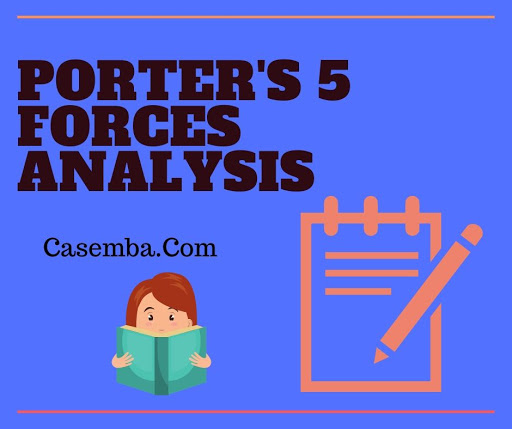Porter's 5 Forces of When To Drop An Unprofitable Customer Commentary For Hbr Case Study Case Study Analysis
This is not the actual case solution. To get the case solution place your order on the site and contact website support.
Home >> Robert S Kaplan >> When To Drop An Unprofitable Customer Commentary For Hbr Case Study >> Porters Analysis
Porter's Five Forces of When To Drop An Unprofitable Customer Commentary For Hbr Case Study Case Analysis
The porter 5 forces model would assist in gaining insights into the Porter's Five Forces of When To Drop An Unprofitable Customer Commentary For Hbr Case Study Case Solution industry and measure the likelihood of the success of the alternatives, which has been thought about by the management of the business for the purpose of handling the emerging problems connected to the reducing subscription rate of customers.
1. Intensity of rivalry
 It is to alert that the Porter's Five Forces of When To Drop An Unprofitable Customer Commentary For Hbr Case Study Case Solution is a part of the international show business in the United States. The company has actually been participated in providing the services in more than ninety countries with the video as needed, items of streaming media and media provider.
It is to alert that the Porter's Five Forces of When To Drop An Unprofitable Customer Commentary For Hbr Case Study Case Solution is a part of the international show business in the United States. The company has actually been participated in providing the services in more than ninety countries with the video as needed, items of streaming media and media provider.
The industry where the Porter's 5 Forces of When To Drop An Unprofitable Customer Commentary For Hbr Case Study Case Help has been operating because its creation has lots of market gamers with the considerable market share and increased profits. There is an intense level of competitors or rivalry in the media and entertainment market, compelling companies to aim in order to maintain the current clients by means of providing services at budget-friendly or affordable rates.
Soon, the intensity of competition is strong in the market and it is important for the company to come up with unique and innovative offerings as the audience or clients are more sophisticated in such modern-day innovation age.
2. Threats of new entrants
There is a high cost of entryway in the media and entrainment industry. The entertainment industry requires a large capital quantity as the business which are taken part in supplying home entertainment service have larger start-up expense, that includes:
Legal cost.
Marketing expense.
Distribution cost.
Licensing cost.
In contrast, the existing entertainment service provider has actually been extensively dealing with their targeted sections with the specific specialization, which is why the threat of brand-new entrants is low.
Another crucial factor is the intensity of competition within the essential market gamers in the industry, due to which the new entrant hesitate while getting in into the market. The innovation and trends in the media market are progressing on constant basis, which is adapted by market rivals and Porter's 5 Forces of When To Drop An Unprofitable Customer Commentary For Hbr Case Study Case Solution.
3. Threat of substitutes
The risk of replacements in the market posture moderate risk level in media and the show business. The company is facinga strong competitors from the rivals offering similar services through online streaming and rental DVDs. Also, the traditional media content supplier is one of the example of the replacement items. The customer might also take part in other pastime and source of details as compared to viewing media material and online streaming.
4. Bargaining power of buyer
The characteristics of media and home entertainment market enables the customers to have high bargaining power. The low expense of changing makes it possible for the consumers to look for other media service suppliers and cancel their Porter's Five Forces of When To Drop An Unprofitable Customer Commentary For Hbr Case Study Case Analysis membership, hence increasing the service hazard.
5. Bargaining power of suppliers
Because Porter's 5 Forces of When To Drop An Unprofitable Customer Commentary For Hbr Case Study Case Analysis has been contending against the standard supplier of home entertainment and media, it needs to show higher flexibility in agreement as compared to the standard services. The products is innovation based, the dependence of the business are increasing on constant basis.
Goals and Objectives of the Company:
In Illinois, United States of America, one of the greatest producer of sensor and competitive organization is Case Option. The organization is associated with manufacturing of large item range and development of activities, networks and processes for achieving success among the competitive environment of market offering it a significant benefit over competitiveness. The organization's goals is mainly to be the producer of sensor with high quality and extremely tailored organization surrounded by the premium market of sensor production in the United States of America.
The goal of the organization is to bring decrease in the item rates by increasing the sales unit for every single product. The organizational management is involved in decision of prospective products to use their client in both long term and short term suggests. The organizational strength involves the facility of competitive position within the production market of sensing unit in the United States of America on the basis of five pillars that includes consumer care, effectiveness in operation management, recognition of brand name, customizable capabilities and technical innovation.
The company is a leading one and carrying out as a leader in the sensor market of the United States for their personalized services and systems of sensing unit. The company has utilized cross-functional supervisors who are responsible for modification and understanding of the organization's strategy for competitiveness whereas, the organization's weak point includes the choice making in regard to the items' removal or retention just on the basis of financial aspects.
